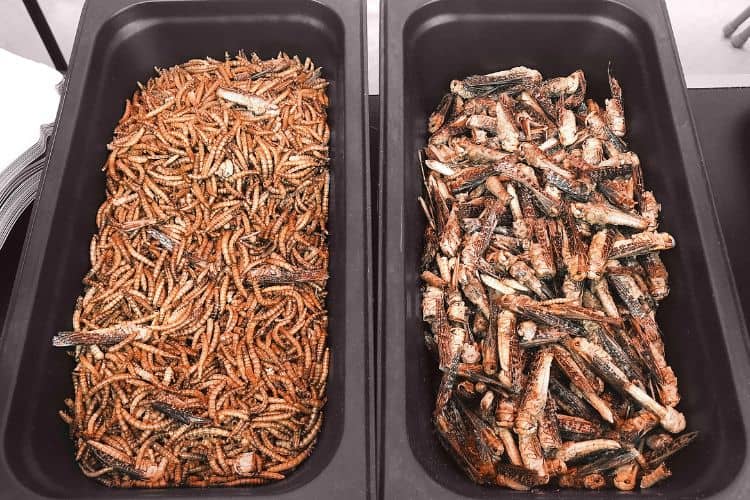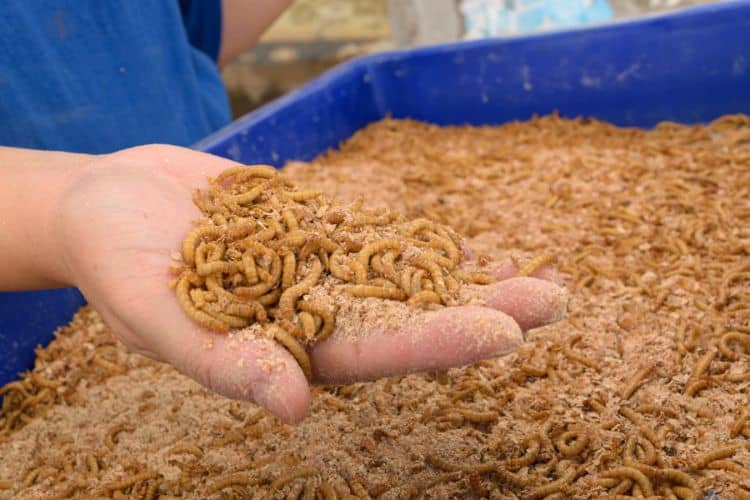Are you a proud owner of a leopard gecko looking for the best way to store mealworms?
Mealworms are a staple part of a gecko’s diet, but keeping them fresh and healthy can sometimes be a challenge.
Luckily, there are a couple of simple methods you can use to store mealworms effectively. This article discusses how to store mealworms for geckos, as well as the difference between storing them live or refrigerated.
Live Mealworms vs. Refrigerated Mealworms: Which Is Better?
There are two ways to store mealworms: keeping them alive for as long as possible to encourage growth and eventual pupation, or storing them cold in the refrigerator to prolong their lifespan and slow down their development.
Each method has its advantages and considerations, catering to the different needs and preferences of gecko owners.
Keeping Mealworms Alive
Keeping mealworms alive involves creating a suitable environment for their growth and development. The advantages of such a storage process include:
- Natural Stimulation: Live mealworms engage your gecko’s natural hunting instincts, providing mental stimulation and physical exercise. This mimics the hunting experience in the wild, promoting natural behaviors and enhancing their overall well-being.
- Nutritional Value: Live mealworms are often considered more nutritious than their refrigerated counterparts. They retain their moisture content and freshness, providing a rich source of essential nutrients for your gecko’s diet.
- Enrichment: Hunting live prey provides enrichment for your gecko, offering them a dynamic and engaging feeding experience. This can help prevent boredom and reduce stress, promoting a healthier and happier gecko.
- Natural Feeding Behavior: Feeding live mealworms allows your gecko to exhibit natural feeding behaviors, such as stalking, chasing, and capturing prey. This engagement with their food promotes a sense of satisfaction and fulfillment for your gecko.
That said, keeping live meal worms comes with its challenges. One downside is that they require more attention and care compared to refrigerated ones. You’ll need to regularly clean their container, provide fresh food, and make sure they don’t escape.
Plus, there’s always the risk of some mealworms turning into beetles if they’re not eaten by your gecko in time, which can be a hassle to manage.
Another drawback is that live mealworms can be a bit more expensive and less convenient to purchase compared to refrigerated ones. You’ll need to make trips to the pet store more often, and sometimes finding live healthy mealworms in stock can be tricky.

Storing Mealworms in the Refrigerator:
Despite popular belief, refrigerated mealworms are not dead but rather in a state of dormancy due to the cooler temperatures. They’re alive but slow-moving and appear almost immobile.
Storing mealworms in the refrigerator is a convenient method to prolong their lifespan and maintain freshness. They can be kept cold for several weeks without the need for additional care, making them convenient for people with busy schedules.
Advantages of keeping mealworms in the refrigerator include:
- Extended Shelf Life: Refrigerated mealworms have a longer lifespan compared to those kept at room temperature. They can be stored for several weeks without the need for additional care, ensuring a constant supply of fresh prey for your gecko.
- Convenience: Refrigerated mealworms can be purchased in bulk and stored in the refrigerator until needed. It allows you to have a readily available food source without frequent trips to the pet store.
- Reduced Risk of Escape: Refrigerated mealworms remain dormant and inactive, significantly reducing the risk of escape from their container.
- Minimal Maintenance: Unlike live mealworms, which require regular feeding and care, refrigerated mealworms require minimal maintenance. You don’t need to worry about providing food or cleaning their container as often.
Storing mealworms in the refrigerator has its perks, but it also has some downsides.
For instance, refrigerated mealworms aren’t as exciting for your gecko as live ones. Live mealworms give your gecko a chance to hunt and play, keeping them active and engaged.
But refrigerated mealworms just sit there—they don’t move or do anything interesting, which might make feeding time a bit dull for your gecko. Plus, some geckos just prefer the taste and texture of live mealworms.
Another downside is that refrigerated mealworms might not be as nutritious as live ones. Over time, the nutrients in refrigerated mealworms can break down, so they aren’t good for your gecko’s health.
How to Store Live Mealworms
Storing live mealworms is pretty straightforward. Here’s what you need to do:
- Get a Container: Find a plastic container with a lid that closes tightly. Make sure it’s big enough to hold all your mealworms comfortably.
- Add Some Bedding: Put some oats, wheat bran, or dry oatmeal at the bottom of the container. This gives the mealworms something to crawl around in and helps keep them comfy.
- Put in the Mealworms: Carefully dump your live mealworms into the container. Spread them out so they’re not all piled up on each other.
- Give Them Food: Drop in some pieces of fruits or veggies for the mealworms to munch on. You can also use special mealworm food from the pet store if you have it. Just make sure to change the food every so often to keep it fresh.
- Let Them Breathe: Make sure the container has some holes or vents so the air can get in and out. This helps keep the mealworms healthy and happy.
- Keep Them Warm: Keep the container at room temperature—around 70 to 80°F (21 to 27°C) is perfect. Avoid putting them in direct sunlight or near anything that gets too hot or cold.
- Check on Them: Now and then, take a peek at your mealworms. Make sure they’re moving around and not looking sick. If you see any dead mealworms or mold, take them out right away.

How to Store Mealworms in the Refrigerator
Here’s how to store mealworms in the refrigerator to keep them healthy and alive for a long time:
- Prepare a Container: Choose a well-ventilated container with smooth sides and a breathable lid. Plastic containers with mesh lids or fabric stretched across the top work well.
- Add Substrate: Add about 1 to 2 inches of a dry, absorbent bedding material like rolled oats, bran flakes, or cornmeal. You can also use crushed egg cartons.
- Feed Them Food: While they don’t need constant feeding in the fridge, provide a small amount of fresh vegetables like carrots or potatoes for moisture. Don’t use fruits as they mold quickly.
- Store in the Refrigerator: Store the container in the warmest part of your refrigerator, ideally between 45 to 50°F (7 to 10°C). Avoid areas near the freezer or vents where temperatures fluctuate.
- Manage Moisture: Check the moisture level every few weeks. The bedding should be slightly damp but not soggy. If it’s dry, add a small piece of apple or potato for moisture. If it’s too wet, remove the wet food and replace some bedding.
- Cleaning: Every few months, remove the mealworms from the container and clean it with hot soapy water. Rinse well and air dry completely before adding fresh bedding and returning the mealworms. If you see any dead ones or mold, take them out right away.
Final Thoughts
Storing mealworms correctly is key to keeping your gecko well-fed and happy.
Whether you go for live mealworms or refrigerated ones, each has its pros and cons.
Live ones give your gecko a natural experience but need more care, while refrigerated ones are easier to handle but don’t offer as much excitement.
Just follow the steps we’ve outlined, and you’ll be all set to provide your gecko with nutritious meals whenever they’re hungry.

